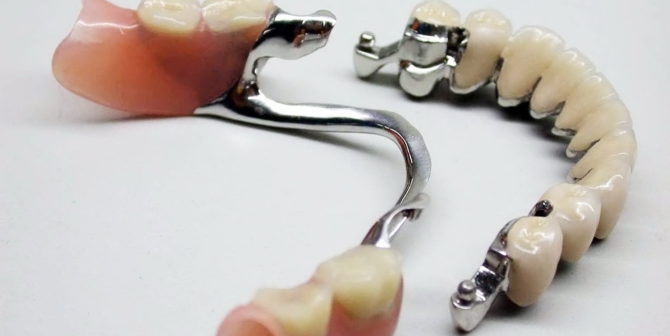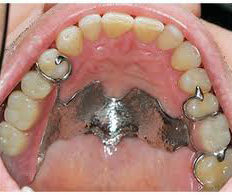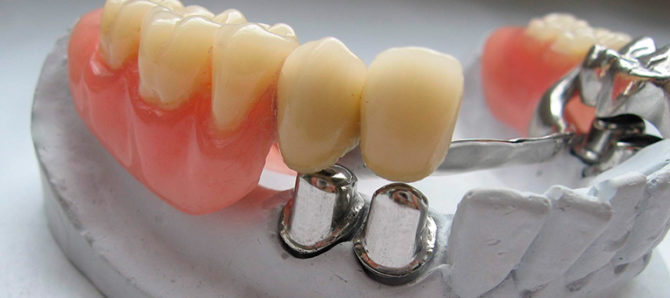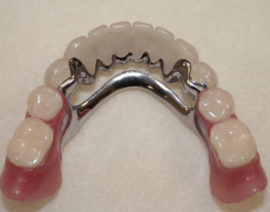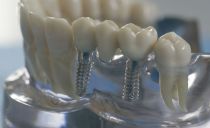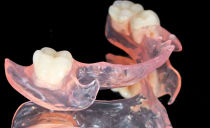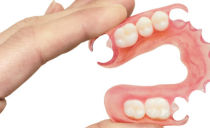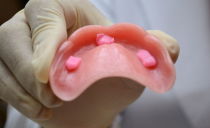Dental prosthetics with arch prostheses: design features, types, cost
Keeping your teeth up to old age, despite dental innovations, is not always possible. Therefore today a popular method for restoring an incomplete dentition is the installation of a clasp prosthesis. Thanks to the use of this design in dentistry, it became possible to eliminate such a problem as the absence of many molars, premolars and incisors.
Content
Characteristics of arch prosthetics
Clasp denture is an advanced orthopedic plate design. When it is not possible to install a bridge, this is the option of prosthetics that comes to the rescue.
Unlike a plastic plate, a clasp with a metal arc is more convenient to use, looks better and more compact.
Clasp structure
Clasp prosthetics is one of the latest dental techniques to restore the completeness of the dentition. Orthopedic products of this type consist of the following parts:
-
cast metal frame;
- fasteners;
- acrylic imitation gums;
- artificial teeth.
The installation of a clasp prosthesis is recommended in case of partial absence of teeth, if it is impossible to resort to a fixed bridge-like prosthetics. None of the existing types of prostheses are equipped with such a thin and almost imperceptible jumper as a denture clasp. The metal arc gives the structure strength, reliability and ensures even distribution of the masticatory load.
Pluses of removable clasps
Like any orthopedic design, clasps have both pros and cons. Among the preferred parameters, the following are distinguished:
- a thin metal arc does not distort taste perception and speech;
- minimum thickness, unlike plastic analogues;
- operational period up to 10 years (with proper care);
- minimum negative impact on the gums in contact with the design;
- high degree of strength;
- possible long-term round-the-clock use;
- unpretentious care.
Cons of removable clasp prostheses
The disadvantages of clasp prostheses are insignificant. These include the following parameters:
- Increased masticatory stress can result in damage to the product. But unlike other types of prostheses, clasp breaks rarely.
- For the manufacture of a convenient and reliable design, you must turn to highly qualified specialists, who are easy to find in Moscow and other major cities of the Russian Federation.
- Installation of all types of clasp prostheses requires special preparation and careful inspection of every detail.
- High cost, especially when installing a splint construction.
Indications for prosthetics
Clasp prostheses are recommended if there are such indications:
- lack of all front or back teeth on the lower or upper jaw;
- removal of several dental units;
- the complete absence of molars and premolars on one or both sides of the jaw;
- deep bite;
- inflammatory periodontal diseases;
- pathological abrasion of enamel;
- preparation for implant placement.
Contraindications to prosthetics
Contraindications to the installation of clasps are:
- full adentia;
- chronic course of neurological and mental diseases;
- shortened frenum of the tongue;
- high bottom of the mouth;
- the presence of allergies to the materials used;
- dental diseases in which it is impossible to fix the structure;
- acute inflammation of the oral mucosa;
- diabetes;
- displacement of the dentition;
- oncological diseases;
- chronic inflammation of periodontal tissues;
- gum recession - exposure of tooth roots.
Types of clasp prostheses
Only an experienced dentist can choose the type of removable prosthesis and determine the feasibility of its installation. To assess the condition of the teeth and the degree of adentia allows a standard examination of the oral cavity. For a more accurate diagnosis, you will have to take an X-ray or orthopantomogram.
According to the material of manufacture
Clasp dentures are classified according to the material of manufacture into the following types:
- Metal free. They do not contain metal, therefore they are suitable for patients with an allergic reaction to this material.
- Plastic The gum base is made of plastic.
A variety of plastic structures are considered acetal removable clasp prostheses. The metal frame in them is replaced by acetal, which is lightweight and easy to use.
- Metal. Titanium, cobalt-chrome and gold-platinum alloys are used for the manufacture of a skeleton or solid product.
- Ceramic-metal - clasp prostheses on telescopic crowns.
If you are allergic to metal, you can install the Quadrotti prosthesis, in which all metal elements are replaced by translucent plastic ones.
By type of mounting system
According to the type of fastening systems, the clasps are divided into three main types: clasp, lock, telescopic. In addition, they are splinting and implantable.
Clasp dentures with clasps
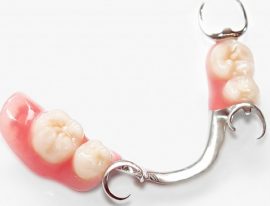 To fix the clasp prostheses, metal hooks are used, fixed on the abutment teeth. Such products are quickly put on and removed, easy to manufacture, and are of low cost. If necessary, additional dental units can be attached to the clasp.
To fix the clasp prostheses, metal hooks are used, fixed on the abutment teeth. Such products are quickly put on and removed, easy to manufacture, and are of low cost. If necessary, additional dental units can be attached to the clasp.
A significant disadvantage of the product is the low level of aesthetics: hooks are sometimes noticeable during a conversation. But despite this, the clasp clasp design is the most popular.
Clasp dentures with telescopic crowns
The most expensive and improved type of arch prostheses are products with telescopic crowns. With this method of prosthetics, metal crowns are placed on the supporting teeth, and ceramic crowns are placed on the clasp prosthesis. The upper clasp is removable, the bottom is not. In dentistry, such designs are rarely used because of the complexity of manufacturing.
Clasp dentures on locks
Some arch prostheses are equipped with attachments - fixing locks that prevent the decrease of the jaw bone. Such orthopedic constructions have a small load on the gums, therefore, they have a significant advantage - the possibility of comfortable and safe wearing.
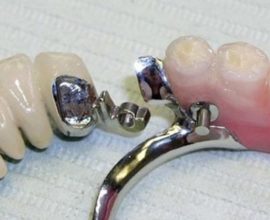 Attachments are divided into crossbar, rail and spherical. The expediency of choosing one or another type of attachment is determined by the dentist.
Attachments are divided into crossbar, rail and spherical. The expediency of choosing one or another type of attachment is determined by the dentist.
Convenience when using prostheses on attachments is obvious:
- they are easily removable, firmly fixed, easy to care for;
- several dental units can be installed on one clasp.
The cost of such a prosthesis will be higher due to the complexity of the design and the necessary accuracy of calculations in its manufacture.
Splinting arch prosthetics
A feature of clasp prostheses is the possibility of their installation with movable lateral and front dental units. In the presence of loose teeth, this prosthetics option is the only one that you can resort to.
Splinting with arch prostheses is used in the presence of chronic inflammatory and degenerative pathologies in the mouth. Moving teeth are fixed with a thin arc that repeats their shape and runs along the inner surface of the jaw. It allows you to keep your teeth in a certain position and helps to normalize their condition.
Splinting prostheses can be installed in the absence of all teeth on one side of the jaw: when there is no support for fixing a standard clasp.
Clasp dentures for splinting teeth are suitable for patients with such pathologies:
- displacement of dental units in a row;
- periodontal disease and periodontitis;
- lack of supporting teeth;
- the presence of exposed roots.
Such a clasp apparatus provides for the presence of metal locks that fix individual dental units and prevent their further loosening. They do not come into contact with the mucous membrane of the oral cavity, which prevents its injury during eating.
Clasp construction on implants
Prosthetics with clasp prostheses on implants are used in the absence of support units. In this case, instead of their own teeth, artificial implants are implanted in the jawbone, which perform the supporting and fixing function. The method of further fixation of the prosthesis is determined by the dentist.
Clasp prosthetics prices
The prices for clasp removable dentures are diverse, as they are formed taking into account the following factors:
- the degree of difficulty in preparing for prosthetics;
- features of the manufacture and installation of the structure;
- type of fixture.
In Russia the cost of the prosthesis on clasps starts from 15 thousand p., and splinting - from 20 thousand p. A design with a castle mount will cost more than a clammer - from 50 thousand rubles. Prices for unilateral prostheses start from 36 thousand rubles.
Implant prosthetics cost from 90 to 200 thousand rubles. - The final cost depends on the number of implants, crowns and the need for bone growth. The cost of the popular nylon prosthesis Quadrotti starts from 45 thousand p. (for one jaw).
The most expensive type of partially removable structures manufactured in modern dentistry clinics is clasp dentures on telescopic crowns - their prices range from 100 to 200 thousand rubles.
With all the pros and cons, arch prosthetics are not much inferior to implantation. Clasp installation is the best way to restore the completeness of the upper and lower dentition.

